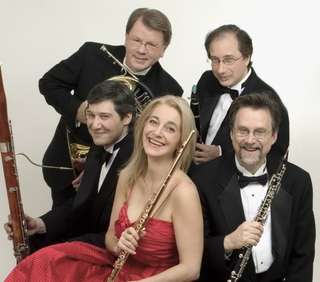|
Back
Fanfares for an Uncommonly Happy Man New York
Sharp Hall, Juilliard School
02/11/2010 -
Elliott Carter: Eight Etudes and a Fantasy – Tre Duetti (World Premiere) – Retracing II for solo horn (World Premiere) – Nine By Five (World Premiere, commissioned by The Juilliard School) – Woodwind Quintet – Wind Rose (U.S. Premiere)
Jean Françaix: Quintette
Conversation with Elliott Carter and Juilliard Provost and Dean Ara Guzelimian
New York Woodwind Quintet: Carol Wincenc (Flute), Stephen Taylor (Oboe), Charles Neidich (Clarinet, Conductor), Marc Goldberg (Bassoon), William Purvis (Horn), Rolf Schulte (Violin), Fred Sherry (Cello), Students of the New York Woodwind Quintet Seminar

E. Carter (© John Streider)
Had a visitor to Sharp Hall seen but not heard Elliott Carter during his post-intermission interview last night, he might have thought the dapper cherubic man was talking about plans for a circus act. Laughing, speaking non-stop, Mr. Carter explained his subject with arms raised high, low and wide. Evidently having the time of his life, he could have been miming trapeze movements or double somersaults. Whatever it was, Mr. Carter was describing something of infinite joy.
This was no circus. Mr. Carter was talking about the half-dozen works being played on this special night at Juilliard. Not only his music–most of played by its original dedicatees–but the polarities of two early pieces in 1948, to four recent works, written after his 100th birthday some 14 months ago.
The entire process was a joyride, as he admitted in the interview. “I would never write anything which I didn’t want to write,” he said. And anybody who assumed that dissonant music had to be gloomy music never heard Mr. Carter, the very great student of another joyous composer, Charles Ives.
One early work, Eight Etudes and a Fantasy gained instant fame some 60 years ago for its “one-note etude” where the winds play different color combinations on a single note. The unexpected inspiration came from fragments given to Columbia University students, exploring eight possibilities of timbre, ending with a Baroque style fantasy. This might have been an early work, but last night, with the New York Woodwind Quintet, it showed Ye Complete Musical Magician juggling ideas in the air. The Fantasy was, yes a complex fugue, but it took the previous ideas, bounced them around rhythmically, ending with musical flourishes.
Mr. Carter’s Quintet comes from a year before, in 1948, and was paired with a quintet from the same year by his fellow Boulanger student, Jean Françaix. The latter could have been equally well composed by Françaix, Ibert or even Poulenc. Basically this was augmented merry-go-round music: quick, momentous, clever and deliciously artificial. Mr. Carter’s work had the same clarity, the same mastery of counterpoint, but already the composer was experimenting with rhythmic changes, themes which were a bit off-putting. Mr. Carter’s short piece was caviar, M. Françaix was a tiny chocolate mint.

New York Woodwind Quintet (© NYWQ)
The New York Woodwind Quintet did what only 19th Century composers used to do. They played the world premiere of the Juilliard-commissioned Nine By Five during both halves of the program. The “five” was the quintet, the “nine” were the number of instruments and their replacements, like contra-bassoon, E flat clarinet, piccolo, and English horn. It began with a piccolo shriek by Carol Wincenc, and continued with lines intermingling, and changing colors dramatically. Like a New England mechanic, Mr. Carter knows his instruments well. Does the bassoonist need time to pick up the contra-bassoon? He stops for a few measures, and the deep growling instrument plays a solo. Does the clarinet play a presto tune on his usual B flat instrument? Give him a measure and he continues higher on the E flat. It was a rollicking piece, but with such richness of invention that it was riveting.
There were two smaller groups. Horn soloist William Purvis played the Retracing II, actually the horn part from Mr. Carter’s Piano Quintet, written when he was a child of 81. It showed not only Mr. Purvis’s commanding sound, but demonstrated how one instrument in an ensemble has a distincitve and line.
The Three Duets were played by violinist Rolf Schulte and legendary cellist Fred Sherry, who, to composers, is what violinist Joachim was to 19th Century composers. For the first movement, Mr. Sherry was “pizzed.” That is, he played dozens of pizzicato combinations with the violin. The three movements were part of Mr. Carter’s “Dialogue” style. The two instruments spoke to each other: berating, chiding, laughing, fighting, enjoying.
Perhaps most exciting of this so happy program was Wind Rose, written two years ago for “large woodwind ensemble”. These included about 24 wind players, conducted by Charles Neidich. For a master contrapuntalist, Mr. Carter didn’t have a single piece of counterpoint. Instead, the groups played 12-tone chords, in different combinations with different textures, varying the metres, scampering from one consort to another, varying colors, bringing back familiar chords, going onto new ones.
Was it a circus act? No, Mr. Carter is much too careful for that. And so careful that you never hear the mechanics, you never can discover what makes it work. Mr. Carter the magician does know how it works, and so happy was he after Wind Rose, he rose himself, waving a bouquet around in well-deserved triumph.
Harry Rolnick
|